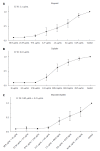Establishment, functional and genetic characterization of a colon derived large cell neuroendocrine carcinoma cell line
- PMID: 30197480
- PMCID: PMC6127660
- DOI: 10.3748/wjg.v24.i33.3749
Establishment, functional and genetic characterization of a colon derived large cell neuroendocrine carcinoma cell line
Abstract
Aim: To establish cell line and patient-derived xenograft (PDX) models for neuroendocrine carcinomas (NEC) which is highly desirable for gaining insight into tumor development as well as preclinical research including biomarker testing and drug response prediction.
Methods: Cell line establishment was conducted from direct in vitro culturing of colonic NEC tissue (HROC57). A PDX could also successfully be established from vitally frozen tumor samples. Morphological features, invasive and migratory behavior of the HROC57 cells as well as expression of neuroendocrine markers were vastly analyzed. Phenotypic analysis was done by microscopy and multicolor flow cytometry. The extensive molecular-pathological profiling included mutation analysis, assessment of chromosomal and microsatellite instability; and in addition, fingerprinting (i.e., STR analysis) was performed from the cell line in direct comparison to primary patient-derived tissues and the PDX model established. Drug responsiveness was examined for a panel of chemotherapeutics in clinical use for the treatment of solid cancers.
Results: The established cell line HROC57 showed distinct morphological and molecular features of a poorly differentiated large-cell NEC with KI-67 > 50%. Molecular-pathological analysis revealed a CpG island promoter methylation positive cell line with microsatellite instability being absent. The following mutation profile was observed: KRAS (wt), BRAF (mut). A high sensitivity to etoposide, cisplatin and 5-FU could be demonstrated while it was more resistant towards rapamycin.
Conclusion: We successfully established and characterized a novel patient-derived NEC cell line in parallel to a PDX model as a useful tool for further analysis of the biological characteristics and for development of novel diagnostic and therapeutic options for NEC.
Keywords: Individualized medicine; Large cell neuroendocrine carcinoma; Patient-derived tumor model.
Conflict of interest statement
Conflict-of-interest statement: To the best of our knowledge, no conflict of interest exists.
Figures






Similar articles
-
Establishment and characterization of cell lines from chromosomal instable colorectal cancer.World J Gastroenterol. 2015 Jan 7;21(1):164-76. doi: 10.3748/wjg.v21.i1.164. World J Gastroenterol. 2015. PMID: 25574089 Free PMC article.
-
New model for gastroenteropancreatic large-cell neuroendocrine carcinoma: establishment of two clinically relevant cell lines.PLoS One. 2014 Feb 14;9(2):e88713. doi: 10.1371/journal.pone.0088713. eCollection 2014. PLoS One. 2014. PMID: 24551139 Free PMC article.
-
Establishment, functional and genetic characterization of three novel patient-derived rectal cancer cell lines.World J Gastroenterol. 2018 Nov 21;24(43):4880-4892. doi: 10.3748/wjg.v24.i43.4880. World J Gastroenterol. 2018. PMID: 30487698 Free PMC article.
-
Neuroendocrine Cancer, Therapeutic Strategies in G3 Cancers.Digestion. 2017;95(2):109-114. doi: 10.1159/000454761. Epub 2017 Feb 4. Digestion. 2017. PMID: 28161703 Review.
-
Pulmonary large cell neuroendocrine carcinoma: its place in the spectrum of pulmonary carcinoma.Ann Thorac Surg. 2007 Aug;84(2):702-7. doi: 10.1016/j.athoracsur.2007.03.093. Ann Thorac Surg. 2007. PMID: 17643676 Review.
Cited by
-
Microsatellite Status and IκBα Expression Levels Predict Sensitivity to Pharmaceutical Curcumin in Colorectal Cancer Cells.Cancers (Basel). 2022 Feb 17;14(4):1032. doi: 10.3390/cancers14041032. Cancers (Basel). 2022. PMID: 35205780 Free PMC article.
-
TGF-β1 increases cellular invasion of colorectal neuroendocrine carcinoma cell line through partial epithelial-mesenchymal transition.Biochem Biophys Rep. 2022 Mar 1;30:101239. doi: 10.1016/j.bbrep.2022.101239. eCollection 2022 Jul. Biochem Biophys Rep. 2022. PMID: 35252596 Free PMC article.
-
Establishment of Novel Neuroendocrine Carcinoma Patient-Derived Xenograft Models for Receptor Peptide-Targeted Therapy.Cancers (Basel). 2022 Apr 10;14(8):1910. doi: 10.3390/cancers14081910. Cancers (Basel). 2022. PMID: 35454817 Free PMC article.
-
Isolation and Characterization of Two Novel Colorectal Cancer Cell Lines, Containing a Subpopulation with Potential Stem-Like Properties: Treatment Options by MYC/NMYC Inhibition.Cancers (Basel). 2020 Sep 10;12(9):2582. doi: 10.3390/cancers12092582. Cancers (Basel). 2020. PMID: 32927768 Free PMC article.
-
Preclinical Models of Neuroendocrine Neoplasia.Cancers (Basel). 2022 Nov 17;14(22):5646. doi: 10.3390/cancers14225646. Cancers (Basel). 2022. PMID: 36428741 Free PMC article. Review.
References
-
- Van Buren G 2nd, Rashid A, Yang AD, Abdalla EK, Gray MJ, Liu W, Somcio R, Fan F, Camp ER, Yao JC, Ellis LM. The development and characterization of a human midgut carcinoid cell line. Clin Cancer Res. 2007;13:4704–4712. - PubMed
-
- Yao JC, Hassan M, Phan A, Dagohoy C, Leary C, Mares JE, Abdalla EK, Fleming JB, Vauthey JN, Rashid A, et al. One hundred years after “carcinoid”: epidemiology of and prognostic factors for neuroendocrine tumors in 35,825 cases in the United States. J Clin Oncol. 2008;26:3063–3072. - PubMed
-
- Modlin IM, Oberg K, Chung DC, Jensen RT, de Herder WW, Thakker RV, Caplin M, Delle Fave G, Kaltsas GA, Krenning EP, et al. Gastroenteropancreatic neuroendocrine tumours. Lancet Oncol. 2008;9:61–72. - PubMed
-
- Schnirer II, Yao JC, Ajani JA. Carcinoid--a comprehensive review. Acta Oncol. 2003;42:672–692. - PubMed
-
- Wiedenmann B, John M, Ahnert-Hilger G, Riecken EO. Molecular and cell biological aspects of neuroendocrine tumors of the gastroenteropancreatic system. J Mol Med (Berl) 1998;76:637–647. - PubMed
MeSH terms
Substances
LinkOut - more resources
Full Text Sources
Other Literature Sources
Research Materials
Miscellaneous

